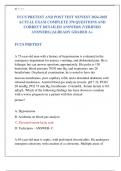1 | P a g e FCCS PRETEST AND POST TEST NEWEST 2024 -2025 ACTUAL EXAM COMPLETE 370 QUESTIONS AND CORRECT DETAILED ANSWERS (VERIFIED ANSWERS) |ALREADY GRADED A+ FCCS PRETEST A 75 -year-old man with a history of hypertension is evaluated in the emergency department for nausea, vomiting, and abdominal pain. He is lethargic but can answer questions appropriately. His pulse is 130 beats/min, blood pressure 70/30 mm Hg, and respirat ory rate 28 breaths/min. On physical examination, he is noted to have dry mucous membranes, poor capillary refill, and a distended abdomen with rebound tenderness. Arterial blood gas analysis reveals: pH 7.32, PCO2 28 mmHg, PO2 74 mm Hg, bicarbonate 13 mmol/L. Serum lactate is 8.0 mEq/L. Which of the following findings has been shown to correlate with a worse prognosis in a patient with this clinical picture? A. Hypotension B. Acidemia on blood gas analysis C. Elevated serum lactic acid D. Tachypnea - ANSWER - C A 65 -year-old man is septic, with perforated diverticulitis. He undergoes emergent colectomy with creation of a colostomy. Multiple areas of 2 | P a g e purulence are identified in the peritoneal cavity. Postoperatively, he continues to be febrile and hypotensive. Chest radiograph is clear. Central venous pressure is 18 mm Hg, and hemoglobin is 13g/dL. Which of the following vasoactive drugs is most approp riate to administer next? A. Epinephrine B. Phenylephrine C. Norepinephrine D. Dobutamine - ANSWER - C A 76 -year-old woman with a history of congestive heart failure and hypertension is admitted with altered mental status and mild upper respiratory symptoms. According to family, her mental status has been gradually declining over the past three to four days . Because of generalized weakness and upper respiratory symptoms, she has had a limited amount of food and drink for the past 72 hours. Her home medications include metoprolol, lisinopril, and furosemide. Her family states that she has been compliant with these medications. On physical examination, vital signs are: heart rate 118 beats/min, blood pressure 96/53 mm Hg, respiratory rate 14 breaths/min, and oxygen saturation 98% on room air. Other findings included dry mucous membranes, poor skin turgor, and t he absence of jugular venous distention. Pulmonary examination is clear on auscultation. She opens her eyes to voice, but mumbles incomprehensible sounds and has - ANSWER - B While fighting a house fire, a 38 -year-old man fell 10 feet through a burning roof into an actively burning bedroom. On arrival at the emergency department two hours later, he has abdominal pain. His focused assessment with sonography in trauma (FAST) exam ination 3 | P a g e shows fluid between his spleen and left kidney. His voice is hoarse, and he has carbonaceous sputum. He has blistering burns on his face and insensate burns over his anterior chest, abdomen, and his entire left upper extremity circumferentially. His respir atory rate is 24 -28 breaths/min, pulse 108 beats/min, blood pressure 131/73 mm Hg, and oxygen saturation as measured by pulse oximetry 98% on 2 liters nasal cannula. His estimated weight is 75 kg (165 lb). Which of the following is the most appropriate nex t intervention for this patient? A. Endotracheal intubation with in -line stabilization for cervical spine protection and 100% oxygen for probable carbon - ANSWER - A A 72 -year-old woman with a history of hypertension, type 2 diabetes mellitus, and smoking develops sudden -onset severe chest pain associated with difficulty breathing and diaphoresis. Her vital signs on arrival in the emergency department are: blood pressu re 165/92 mm Hg, heart rate 101 beats/min, respiratory rate 29 breaths/min, and oxygen saturation as measured by pulse oximetry 96% on room air. Which of the following ECG findings is the most significant indicator for immediate reperfusion in this patient ? A. ST segment depression B. ST segment elevation C. T wave inversions D. Peaked T waves - ANSWER - B A 45 -year-old man is admitted to the hospital with fever, altered mental status, and swelling and redness in the upper thigh and scrotal area of 4 | P a g e four days' duration. He has a history of poorly controlled diabetes and chronic renal insufficiency. On examination, he is lethargic. Vital signs are: heart rate 79 beats/min, blood pressure 90/40 mm Hg, respiratory rate 33 breaths/min, SpO2 88%, and tempe rature 39°C (102.2°F). The right thigh has erythema and cutaneous gangrene. Air is felt by palpation of the soft tissue. Laboratory test results include a white blood cell count of 31,000/µL with 15% bands, hemoglobin 11.5 g/dL, glucose 520 mg/dL, sodium 1 50 meq/L, potassium 4 meq/L, creatinine 2.5 mg/dL (baseline 2.2 mg/dL), and lactate 4.5 meq/L. IV fluids are started for aggressive resuscitation, and he is intubated. Blood cultures are obtained. Which of the following is the most appropriate strategy in this patient's ma - ANSWER - B Which of the following parameters may be a late sign of cardiovascular disturbance signaling failure of the compensatory mechanisms? A. Tachycardia B. Bradycardia C. Hypotension D. Hypertension - ANSWER - C Investigative tests should be based on the patient's history and physical examination as well as on previous tests. Which of the following is one of the most important indicators of critical illness? A. Respiratory acidosis B. Metabolic acidosis C. Elevated creatinine




